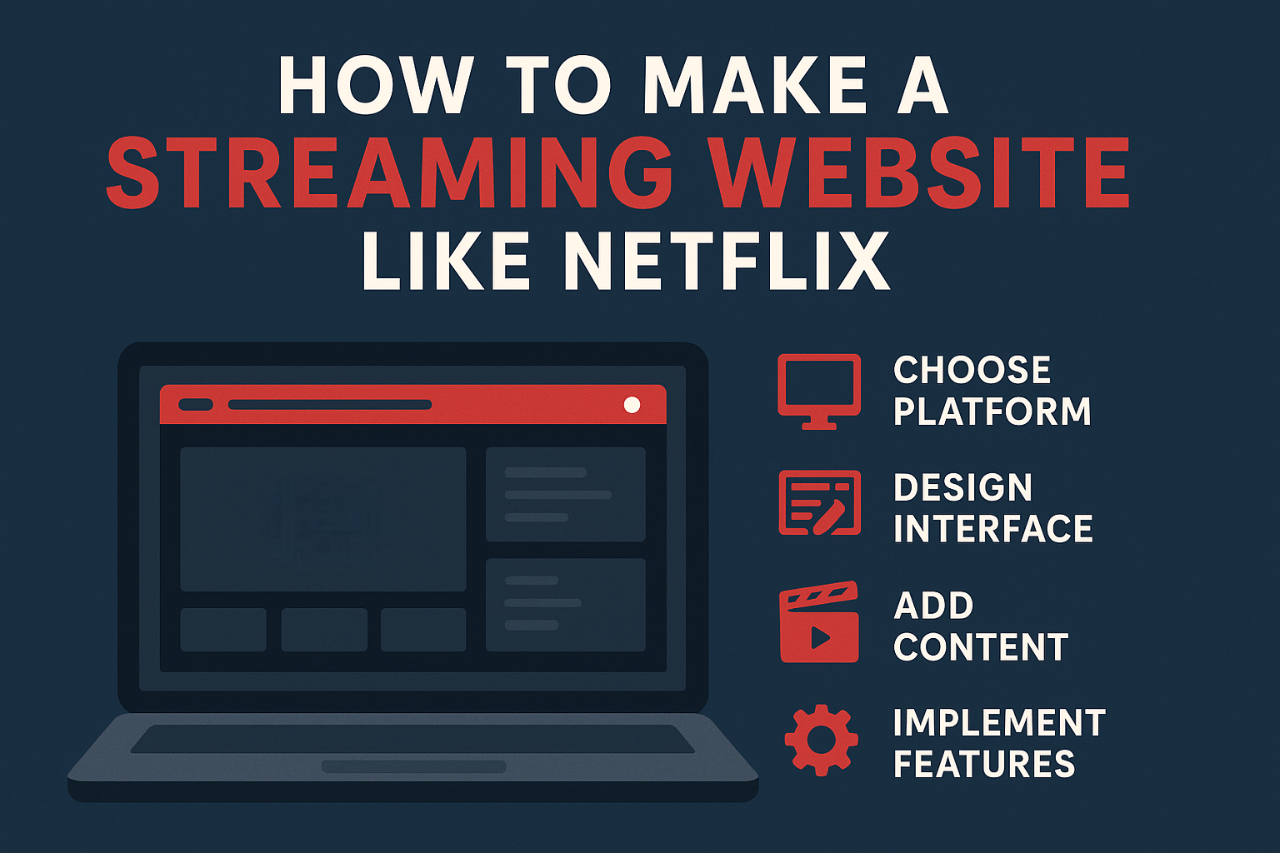The digital entertainment industry is booming, and streaming platforms are at the center of this growth. Audiences across the globe are shifting away from traditional television toward on-demand, personalized streaming platforms. With video consumption rising every year, many entrepreneurs and businesses are now asking a critical question: how to make a streaming website like Netflix?
Building a streaming platform is not only about creating a website it’s about delivering seamless video experiences, ensuring security, handling payments, and scaling for millions of users. In this comprehensive guide, we’ll break down 7 powerful steps to create a video streaming website that can compete with established players and carve out its own space in the market.
Step 1: Define Your Business Model
Before diving into technology, you need to clearly define what your platform will offer. Understanding your business model ensures you build the right features and attract the right audience.
Popular Streaming Business Models:
- Subscription-based (SVOD): Users pay a monthly or yearly fee for unlimited access (like Netflix or Disney+).
- Ad-supported (AVOD): Content is free, but revenue comes from ads.
- Transactional (TVOD): Users pay per video or series (popular for live events or one-time releases).
- Hybrid models: Combining subscriptions, ads, and transactions.
Your choice of business model impacts everything—from user experience to revenue strategies—so decide early before moving to OTT platform development.

Step 2: Plan Features and Functionality
A successful streaming website requires more than just video hosting. Consider the following core features:
Essential Features for Users:
- User registration and profiles
- Personalized recommendations
- Advanced search and filters
- Multi-device compatibility (desktop, mobile, smart TVs)
- Watchlists and favorites
- Multi-language support
Essential Features for Admins:
- Content management system (CMS)
- Analytics and reporting
- Payment gateways and subscription management
- Security tools (DRM, anti-piracy solutions)
- User management and moderation
The complexity of features determines whether you use a custom OTT platform development approach or a pre-built solution.
Step 3: Choose the Right Technology Stack
The technology stack you select will determine your platform’s speed, scalability, and security.
Backend Technologies:
- Programming languages: Python, Node.js, or PHP
- Databases: MySQL, MongoDB, or PostgreSQL
- Streaming protocols: HLS (HTTP Live Streaming), MPEG-DASH
Frontend Technologies:
- Web frameworks: React, Angular, or Vue.js
- Mobile development: Native iOS (Swift), Android (Kotlin), or cross-platform (Flutter, React Native)
Hosting and Infrastructure:
- Cloud platforms like AWS, Google Cloud, or Azure
- CDN (Content Delivery Network) integration for faster video delivery
Choosing the right technology stack ensures your platform can handle traffic spikes and deliver high-quality video.
Step 4: Secure Video Hosting and Delivery
Video content is the heart of your platform, and delivering it seamlessly is non-negotiable.
Steps for Effective Video Hosting:
- Video Storage: Use secure cloud storage to host your files.
- Compression and Encoding: Optimize videos to different resolutions (360p, 720p, 1080p, 4K) for smooth playback.
- Adaptive Bitrate Streaming: Automatically adjusts video quality based on internet speed.
- CDN Integration: Reduces buffering and improves streaming speed worldwide.
For anyone looking to create a video streaming website, reliable hosting and delivery systems are critical.
Step 5: Focus on OTT App Development
While a website is crucial, most users consume content via mobile apps and smart TVs. If you want to reach a wider audience, you’ll need to build an OTT app.
Benefits of Building an OTT App:
- Better user engagement and retention
- Push notifications for new releases
- Offline viewing options
- Compatibility with Roku, Firestick, and Apple TV
App development can be done natively (iOS/Android) or through cross-platform frameworks. Either way, ensuring smooth playback and responsive design is essential.
Step 6: Integrate Security and Monetization
No streaming service is complete without robust security and monetization features.
Security Features:
- Digital Rights Management (DRM): Protects content from piracy.
- Watermarking: Tracks unauthorized distribution.
- Secure payment gateways: Encrypts financial data.
- Two-factor authentication: Safeguards user accounts.
Monetization Options:
- Subscriptions with flexible tiers
- Ads with targeting options
- Pay-per-view events or premieres
- Partnerships with sponsors and affiliates
These features not only protect your content but also ensure long-term revenue growth.
Step 7: Test, Launch, and Scale
After development, rigorous testing is required:
- Performance testing: Ensure fast loading times and smooth video playback.
- Security testing: Identify vulnerabilities.
- User testing: Gather feedback on usability and design.
Once testing is complete, launch your platform with a strong marketing plan. Promote through:
- Social media campaigns
- Influencer collaborations
- SEO-optimized content marketing
- Free trials or promotional discounts
As your user base grows, scaling becomes essential. Cloud infrastructure, CDN expansion, and AI-based personalization can help your platform compete at scale.
Challenges You May Face
Building a streaming platform comes with its share of obstacles:
- High competition from established platforms
- Content licensing and copyright issues
- Infrastructure costs for hosting and bandwidth
- User retention in an overcrowded market
Anticipating these challenges and planning ahead can make your journey smoother.
Future of Streaming in 2025 and Beyond
Streaming technology is evolving rapidly. Here are some trends shaping the industry:
- AI-powered recommendations: Personalized viewing experiences.
- VR and AR streaming: Immersive entertainment.
- Blockchain in streaming: Transparent royalty payments.
- Hyper-local content: Platforms focusing on regional stories.
Keeping pace with these innovations ensures your platform stays relevant.
Conclusion
Learning how to make a streaming website in 2025 is not just about technology—it’s about creating engaging user experiences, ensuring security, and planning monetization. By following these 7 steps, you can create a video streaming website that stands out, leverage OTT platform development for scalability, and eventually build an OTT app to expand your reach.
If you’re ready to bring your vision to life, working with the right technical experts can make all the difference. For those seeking a trusted partner to guide them from concept to launch, findthecoder offers the expertise to design, develop, and scale professional streaming platforms tailored to your goals.

